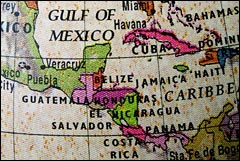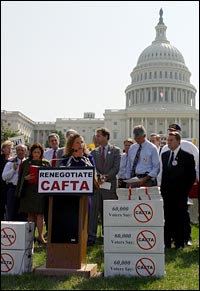Driving down either of El Salvador’s two principal highways, you’re almost sure to end up braking behind a pickup truck that’s jammed with people standing shoulder to shoulder. Occasionally these rural taxis are new vehicles, but most are rickety, rusted, and running on antiquated engines and exhaust-spewing diesel.
Even though 48 percent of Salvadorans live below the poverty line, according to the United Nations Development Program, the huge influx of remittances from migrants in the United States means that more Salvadorans are buying cars, formerly a luxury reserved only for the very rich. And El Salvador is not alone: while Americans and Europeans are buying fewer SUVs and driving less, vehicle sales in most developing countries are on the rise. Toyota’s 2006 first-quarter sales in Central America, for example, were up 9 percent from 2005.
More cars means more gasoline, and gasoline consumption in Central America increased by 10 percent between 2000 and 2003, according to the International Energy Agency. Every Central American country imports oil, so the recent price increases have been painful for these economically weak countries. Costa Rica, for example, saw an increase of 45 percent in oil costs between 2004 and 2005.
With both consumption and oil prices on the rise, leaders are looking for an alternative. Enter biofuels.
The fuss over Brazil’s biofuels bonanza has not gone unnoticed by many of its Latin American and Caribbean neighbors, who, like the mammoth South American country, have been producing sugarcane for centuries. With an annual output of 4.8 billion gallons, Brazil has worked the energy world into a tizzy over the possibility that petroleum-based gasoline may have a viable competitor — or at least partner — in the form of ethanol. It’s an opportunity that has many environmentalists cheering, corn and sugar growers salivating, and oil companies scratching their heads to figure out how to get in on the action.
And it seems that Central America may offer some of the best prospects for biofuel production: a Brazilian government study recently identified the area as a good candidate for reproducing Brazil’s ethanol experiment.
Latin America’s potential has also not escaped notice in the international community. In June, when former U.S. President Bill Clinton met with Inter-American Development Bank President Luis Alberto Moreno, Clinton made the case for Latin America “lead[ing] the world” in biofuels. An alternative-energy strategy in the region, he said, could create jobs, protect the environment, and sharpen Latin America’s competitive edge in the global economy.
Before oil prices surged, most sugar-producing countries saw little reason to invest in ethanol. But oil is up, and sugar is too — prices for the sweet stuff have doubled since early 2005. That’s left many warming to the notion that it may be more profitable to produce sugar for ethanol production than for consumption as a foodstuff. Economically and environmentally, biofuels seem to make good sense.
What’s Happening Now
Several countries in South and Central America have either initiated or are planning national biofuel programs of some kind, including Argentina, Costa Rica, Colombia, El Salvador, Jamaica, Mexico, Nicaragua, Paraguay, Peru, and Venezuela.

Now that’s where I’m talking about.
Photo: iStockphoto
It’s not just ethanol that’s attracting attention. These countries are also looking at new ways of producing biodiesel with native and oil-rich plants like Jatropha curcus, a tree native to the American tropics whose nut can produce about 200 gallons of oil per acre, and African palm, a tree rich with oil.
So who’s venturing into the biofuels arena at full speed? Here’s a look.
Honduras, among the poorest nations in Central America, is seeing dollar signs in sugar, a product that until recently has not held much promise. “We need to reduce our dependence on oil by promoting the production of ethanol and biodiesel,” President Manuel Zelaya said earlier this year. “In addition to fuel, what we can generate is a number of important jobs growing sugarcane.”
The government has encouraged sugar production with subsidies, and farmers have responded by planting 27,200 acres of new sugarcane to supply two ethanol refineries. Zelaya’s agricultural ministry is also looking to enter the biodiesel market, and is using abandoned farmland to plant 494,000 acres of African palm.
In March, El Salvador opened Central America’s first biodiesel plant with financial support from Finland to produce 400 liters a day. The project is part of a public-private partnership between Finland’s Environment and Foreign Affairs Ministries and 34 Central American companies and institutions to cultivate renewable energies and combat climate change. They are feeding the plant with seeds from the Higuerillo tree and the fruits of the Jatropha bush, both native plants.
“Agriculture and biofuels have a future here because we have the ideal climate, good quality land, and six months of rain a year,” said Mario Ernesto Salaverría, El Salvador’s minister of agriculture and livestock. “We also have a lot of available land: only 70 percent of the country’s arable land is currently in use.”
Guatemala already has a Brazilian-designed ethanol plant, though it is not producing car-ready ethanol because local demand is not yet high enough. But experts at the IDB say the country’s ethanol producers will soon be able to sell it internationally. Farmers in Guatemala are also planting Jatropha like their neighbors in Mexico and El Salvador; 300,000 plants are already in the ground courtesy of a private investment by Guatemalan business leader Ricardo Asturias.
Costa Rica, a country well known for its environmental and conservation prowess, has set a target of substituting 7 percent of its gasoline with ethanol by the end of 2008. In early 2006, Costa Rica’s state-run national gasoline refinery RECOPE began a pilot project with Brazilian oil company Petrobras to introduce 7.5 percent ethanol into gasoline at 63 gas stations. But while ethanol is available at virtually every gas station in Brazil, Central American countries may face far more resistance in building consumer confidence in the product: According to IDB, the Costa Rican government hopes to expand the $15 million program across the nation, but ran up against consumer suspicions that the ethanol would ruin car engines.
It’s the Neighborly Thing to Do
Brazil’s partnership with Central American biofuel producers may look like a helping hand, but it’s motivated by bigger-picture interests. Brazilian ethanol producers, who have to pay a 54-cent tariff to export to the United States, have invested in facilities in El Salvador and Jamaica that get duty-free access to the U.S. through the Caribbean Basin Economic Recovery Act, a trade agreement initiated in 1983 designed to promote export-oriented growth in the Caribbean Basin countries. Guatemala, Panama, and the Dominican Republic are also said to be collaborating with the Brazilians to build new distilleries.

Congresspeople get their knickers
in a twist over CAFTA.
Photo: house.gov
The Central America Free Trade Agreement, passed last year by the U.S. Congress and signed by nearly every Central American country, provides other incentives for ramping up biofuels. “The support for sugarcane in CAFTA will help us to expand our alternative-fuel program,” said Ricardo Esmahan d’Aubuisson, president of the Agricultural and Agroindustrial Council of El Salvador.
That has pushed members of the nascent U.S. ethanol industry to complain, saying it hurts those trying to produce ethanol from corn. “By enabling ethanol imports into the U.S., CAFTA undercuts decades of work by farmers, rural communities, and millions of dollars in taxpayers’ investments in federal and state government programs to build this U.S. ethanol industry,” says a report by the Minneapolis-based Institute for Agriculture and Trade Policy.
Central America’s biofuel operators will also have to face up to some environmental critics who wonder what they will do with the vinasse, the high-potassium byproduct of ethanol production from sugarcane. In Brazil they are reusing vinasse as a fertilizer, and IDB hopes Central America can do the same; the agency is beginning a study on the topic.
Other environmentalists have called biodiesel “deforestation diesel” because of a perception that producers are deforesting precious forests to plant oil palms. “There is no limit on [available farmland] in Central America, so I don’t think they’ll have to convert cropland or cut down trees,” said Arnaldo Vieira de Carvalho, a sustainable-energy expert at the IDB. “But we do need to study and plan for these things so that we avoid those kind of impacts. So far it’s not happening in Brazil, so I think it can be avoided elsewhere in the region.”
And still others say biofuels are too energy-intensive to produce and will drive up the cost of foodstuffs the poor barely have access to now. Earth Policy Institute founder Lester Brown, writing in Fortune in August, said, “For the world’s poorest people, many of whom spend half or more of their income on food, rising grain prices can quickly become life threatening.”
Ultimately, experts say, the large-scale development of biofuels in Central America will depend on an influx of private investment and strong political will. And the region should not expect to be able to replicate Brazil’s success.
“Sugarcane production for ethanol is much more oriented toward the large scale, which Brazil has done,” said Suzanne Hunt, biofuels program manager at the Worldwatch Institute in Washington, D.C. “But biodiesel is better suited to the small scale, and Central American governments could focus on biodiesel production.”
Before its potential is tapped, Central America will remain in the position it’s in now: a great unknown between two major biofuels players, Brazil and the U.S. Whether it will be a linchpin or a loser, no one knows.


